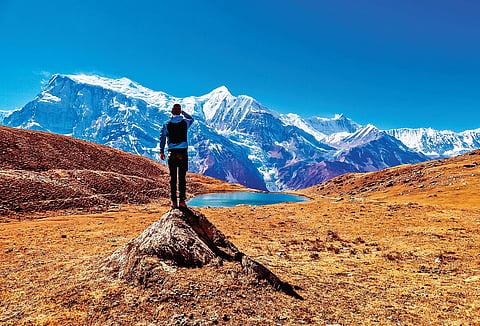

Why would anybody, of their own accord, set off on foot on a long journey, a walk of thousands of kilometres? A walk through the wild, fraught with danger from the elements, from wildlife, from hostile humans—even the very real threat of one’s own body proving unequal to the task?
In the case of Bill Bryson, walking the Appalachian Trail (as documented in his book, A Walk in the Woods), it was an attempt to explore the historical, natural and cultural heritage of an old trail. For Slawomir Rawicz, The Long Walk—which took him and his companions all the way from Siberia to Darjeeling—it was escape from almost certain death in a Siberian prison camp.
For Jono Lineen, it was the death of his younger brother Gareth which led him to go on a solo walk through the Western Himalayas. Gareth, just 19 years old, drowned in a freak accident while rowing on Canada’s Elk Lake, and the shock of his death turned his brother’s life upside-down. In an attempt to cope with the loss of Gareth’s death, and to understand life and death, Jono Lineen chose to explore the Himalayas, which he had been visiting for several years before he began his solo trek.
The long walk documented in Into the Heart of the Himalayas was a 2,700 km trek, which took four months to complete. Lineen began his expedition in northern Pakistan—the ‘Muslim Himalayas’, as he labels this stretch of his route—and worked his way east, through sections of Ladakh, Zanskar, Lahaul and Spiti (the ‘Buddhist Himalayas’), finally ending in Kumaon, the heart of the ‘Hindu Himalayas’.
Along the way, as he chatted with monks and walked past stupas, tied prayer flags at sacred spots, took a dip in the Ganga at its source and sat meditating at the deodar-shrouded Jageshwar Temple, Lineen experienced the famed spirituality of the Himalayas.
Religion and spirituality, however, are only two of the components (even if major) of the Himalayas. As he made his way through some of the most rugged terrain in the world, Lineen saw the life of the people up close.
He harvested barley with villagers, was entertained by a marijuana harvester near Manali, met up with a bear scarer, and was apprehended by the Army for blundering into their camp. He had some hair-raising adventures, saw spectacular natural (and manmade) sights, and participated in conversations on everything from politics to cricket.
Interwoven with this intimate account of a solo walker’s trek through the Himalayas are Lineen’s many reminiscences of his brother. He talks of the icy waters of Chandratal, and remembers Elk Lake’s icy waters where Gareth drowned. He sees the mummified body of a lama at Giu, and is reminded of Gareth’s body, preserved by the cold. Forests, bears, religion, goodness: each of these (and more) find connections with his memories of Gareth.
Into the Heart of the Himalayas is an unforgettable memoir: an intense, vivid account of the natural world and its human counterpart. Lineen writes with sincerity and occasional humour, combining observations with research, explaining concepts, discussing ideas and beliefs. Giving, in the process, his readers a glimpse up close of himself. This is a touching, inspiring, exhilarating book.